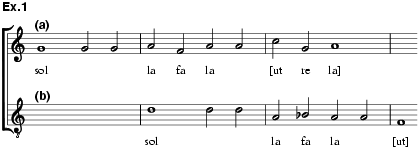
(It.: ‘deception’).
A technique of hexachord transposition resulting in the alteration, development or transformation of thematic material and found particularly in imitative textures of works (mostly non-vocal) written during the later Renaissance and earlier Baroque periods.
Artusi explained the term in the second part of his treatise attacking modern musical practice (1603): ‘The deception [inganno] takes place whenever one part begins a theme and another voice follows it without using the same intervals but still retaining the same names of the hexachord syllables’. He provided an illustration of the technique (ex.1). An initial theme in the natural hexachord (a) is changed (b) by transposing the first pitch into the hard hexachord (D sol replaces G sol) and the third and fifth pitches into the soft hexachord (B fa replaces F fa, and F ut replaces C ut). Although this example is related to a single imitative point, contemporary composers seem to have taken advantage of the technique as a means of interconnecting the thematic material of a whole work. Artusi made it clear that the use of inganni was, however, not confined to his contemporaries (‘li Moderni’) but might be found in the works of earlier composers (‘gli valenti Compositori passati’). He claimed that some modern musicians misunderstood the technique; he was perhaps referring here to the greater flexibility with which it was used in the early 17th century and to its occurrence in dissonant and chromatic contexts.

The only known composition to refer to the term in its title is Trabaci’s ricercare on the 4th tone (1603), ‘con tre fughe et inganni’. Inganni used in his later ricercares (1615) are identified in the musical text. It has been suggested (by Jackson, 1971) that inganni played a part in the chromaticisms of the late polyphonic madrigal, including works by Gesualdo. They are certainly found in many of the polyphonic instrumental and keyboard works of Frescobaldi – thus highlighting the consummate versatility of his handling of thematic variation – and to some extent in the instrumental music of Tarquinio Merula.
The mid-16th century repertory of the Bourdeney Codex (F-Pn Rés.Vm 851) contains the earliest identified examples of the systematic use of inganni in ricercares. Four of these pieces also appear in the Chigi Manuscript (I-Rvat Chigi Q.VIII.206), there attributed to ‘Giaches'; once thought to be Giaches Wert, it is now considered more likely to refer to ‘Giaches Brumel’ (Jacques Brunel; Newcomb, and see RRMR, lxxxix, 1991), organist of the court of Ferrara from about 1532 to 1564. Luzzaschi, Frescobaldi’s teacher, succeeded Brunel, coincided with him at Ferrara, and may have been his pupil. The likelihood that Jacques Brunel was organist of Rouen Cathedral in 1524 may establish successive links between a Franco-Flemish composer and composers working in Ferrara, Rome and Naples. This may suggest that the technique of inganno dates back to the earliest years of imitative composition and may not be confined to Italy. Given the importance of the hexachord system, and especially of hexachordal mutation, in applied music theory and education this would not be a surprise. Although the most systematic use of inganno is found in keyboard and instrumental music, there are less overt examples in 16th-century vocal polyphony, but it is not always possible to determine whether its use is deliberate (Harper, 1978).
G.M. Artusi: Seconda parte dell’Artusi overo Delli imperfettioni della moderna musica (Venice, 1603/R), 45–6
R.J. Jackson: ‘The Inganni and the Keyboard Music of Trabaci’, JAMS, xxi (1968), 204–8
R.J. Jackson: ‘On Frescobaldi’s Chromaticism and its Background’, MQ, lvii (1971), 255–69
J.M. Harper: The Instrumental Canzonas of Girolamo Frescobaldi: a Comparative Edition and Introductory Study (diss., U. of Birmingham, 1975)
J.M. Harper: ‘Frescobaldi’s Early Inganni and their Background’, PRMA, cv (1978–9), 1–12
A. Newcomb: ‘The Anonymous Ricercars of the Bourdeney Codex’, Frescobaldi Studies, ed. A. Silbiger (Durham, NC, 1987), 97–123
G. Trantham: ‘An Analytical Approach to Seventeenth-Century Music: Exploring inganni in Fantasia seconda (1608) by Girolamo Frescobaldi’, College Music Symposium, xxxiii–xxxiv (1993–4), 70–92
JOHN HARPER